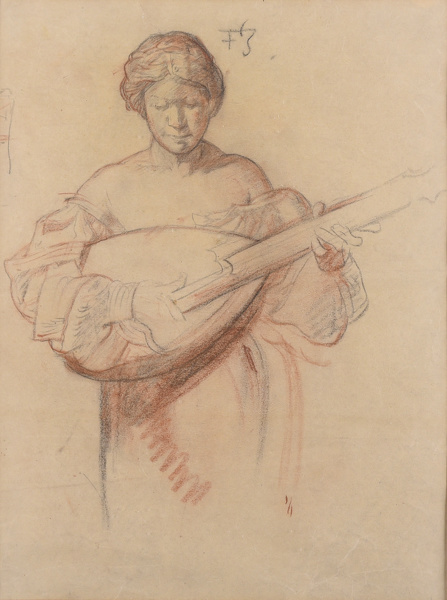
 SOLD
SOLD
Frank Brangwyn:
Harmony,, circa 1903, (M1139)
Framed (ref: 7021)
Signed with monogram charcoal and red chalk
14 1/4 x 10 1/2 in. (36.5 x 27 cm.)
Tags: Frank Brangwyn chalk charcoal leisure women
Provenance: Private collection.
In a limed oak frame with its original mount, some creases to the paper
This is a study for Skinners panel, Harmony.
This drawing will appear as M1139 in Dr Libby Horner's forthcoming Catalogue Raisonne.
A River Procession to Westminster in 1453: City and Trade Barges by Sir Frank Brangwyn RA RWS PRBA HRSA, 1867-1956. Collection: The Skinners Company, London. reproduced in, Frank Brangwyn and His Work, frontispiece

In April 1902 the Court of the Skinners’ Company commissioned Brangwyn to paint six large panels (measuring 289.6x320cm) and four small panels (289.6x152.4cm) which would represent the "stir and colour of the long-drawn Pageant of the Guild". A price of £4000 was offered. By July it was decided to add a further panel in the Gallery (measuring 152.5x365cm) for which Brangwyn would be paid £300, and it was expected that the panels, all oil on canvas, would be completed within five years. (The scheme would not in fact be completed until the 1930's).
Brangwyn was sent a list of what were considered appropriate subjects together with an outline drawing of the Hall on which he sketched his proposals.
The first panel to be completed, Departure of Sir James Lancaster for the East Indies, 1594, was exhibited at the Royal Academy in 1904, the same year that Brangwyn was elected as an Associate. The second panel, River Procession, 1453, (where the figure of Harmony appears in the middleground to the left) was delivered in March 1904.
In 1912 the artist wrote that he would "never forget the obligation I am under to the Skinners Company for having given me an opportunity that has seldom if ever fallen to the lot of a British Artist in this Country, and it has always been my desire to complete my work at Skinners Hall to the best of my ability". Herbert Furst noted the "impression of richness, sumptuousness, due to the co-operation of architecture and painting" and described them as "hanging draperies", whilst Walter Shaw Sparrow felt the decorative panels revealed "such a breadth of vision, such a lyrical swing in design, such a superb virility in handling, as will ever be remarkable in the history of British art."
We are grateful to Dr Libby Horner for assistance. This drawing will appear as reference in her forthcoming catalogue raisonne.









